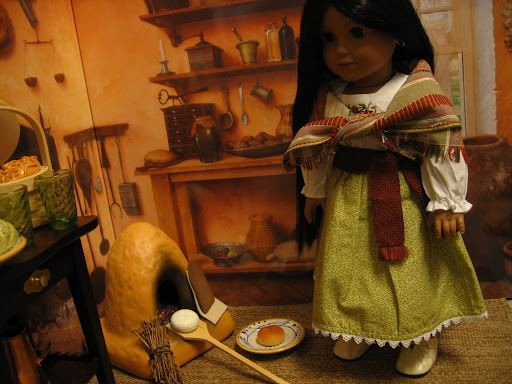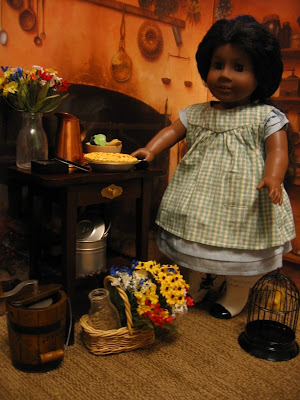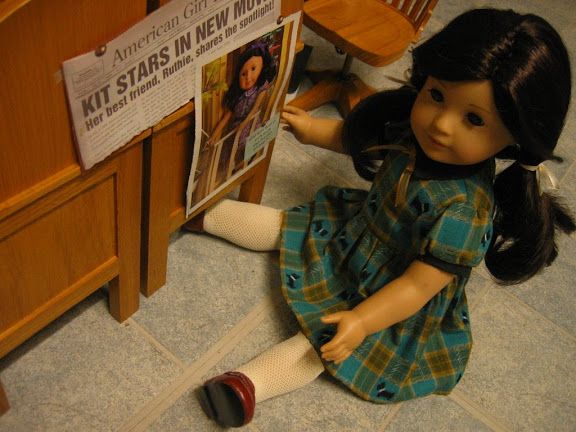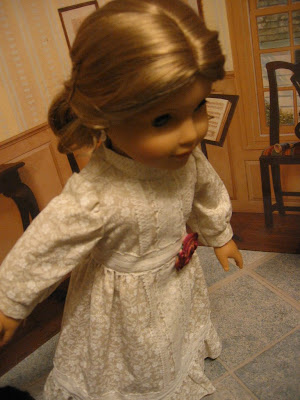Remember Felicity's father owned a general store in Williamsburg, Virginia? I attempted to recreate the store. The background is a retired scenes and settings book that AG used to produce. Can you tell what is part of the scenery book and what is an actual miniature toy I bought? Have fun finding them.
The Textiles Section
Josefina, armed with fashion dolls and the finest textiles from English factories and English traders, tries to entice shoppers.
Selling English imported goods started to become more difficult for shop owners in the 1770s because many of the colonists were angry about taxes and mercantilism and were boycotting English imports in favor of homespun cloth. Some historians argued that the boycott movements propelled women into the political arena, because they controlled what colonial households consumed. Was this empowerment? My friend Kaylan discovered another side of this thesis when she researched female shop owners in the Boston area, who refused to sign non-importation agreements and who were branded as loyalists. After the British evacuated Boston and eventually lost the war, these exiled women lost their stores, their homes, and their means of independence. The women did file claims to the British government for their losses. They got very little back.

Looks like Josefina might have a customer in that Tory Elizabeth Cole!
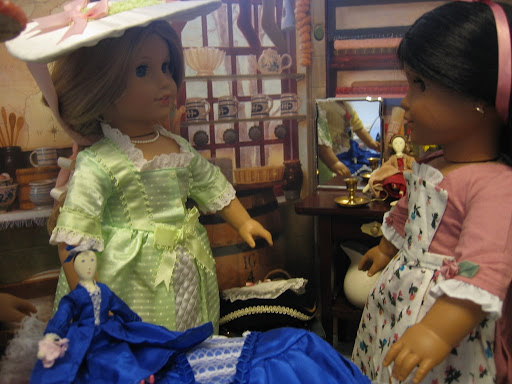
Girls and women in the 18th century did not own that much clothes, so they added variation to their wardrobe by changing stomachers (the triangular bodice attached to the front of the gown), petticoats, and trim detail.
 The Bake Shop Section
The Bake Shop Section
Jess is a baker and she stores queen cakes, bread, and tarts in her pie safe. Actually, if you lived in colonial times, you were more likely to buy the raw ingredients, such as flour and sugar, from the store rather than fresh pastries. But hey, let's pretend. By the way, pie safes were a German-Pennsylvanian tradition, and were meant to keep baked good fresh. So my pie safe's screen grating is rather inaccurate!
Read more about what real pie safes looked like from Antiques Roadshow.

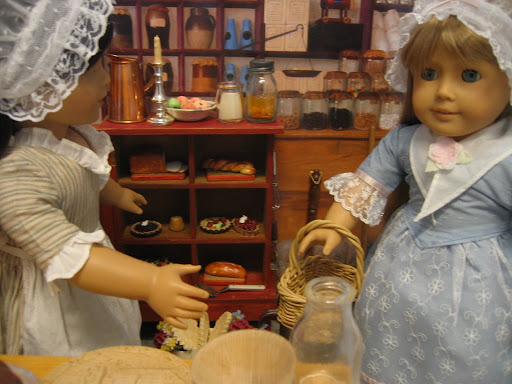
 The Porcelain Section
The Porcelain Section
Marianne is looking for an inkwell. Blue was all the rage in the 18th century, because
blue pigment was expensive to make and therefore conveyed ostentatious wealth. If you wanted to show off, you might commission a portrait of yourself wearing a blue gown. Next time you visit a museum, you should take a note of the paintings' colors especially ones dated before the 19th century. Whether it was the Virgin Mary or a Vermeer painting of milk maids, the paintings with blue figures would have been very expensive commissions.

Marianne sits her at her Windsor writing chair with a swinging arm! To Marianne, the chair is quite new, because the model with the writing arm was invented around 1770. However, it is quite strange that no one painted the chair green or a different color. Read more about Windsor chairs at
Antiques Roadshow or
read a general history. She writes out invitations to a ball. The silver sander is filled with “pounce” to sprinkle on her writing and dry up the ink blots.

Across the room, Kirsten enjoys the sweet treats she had just bought with her tea. Shhh! She's supposed to be drinking chocolate instead of tea, but she's addicted to the stuff. Let's pretend that Kirsten's relatively wealthy. So she gets her tea relatively fresh. Of course, her servants will probably try to resell the tea to the local merchant who will lace it with a bit of arsenic to keep it tasty and resell it to the middle class. Then the middle class bring back the tea leaves and it's sold to the poor...let's just say the poorest rungs of society, if they choose to imitate their betters, get quite the potent mix.




